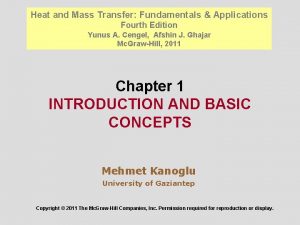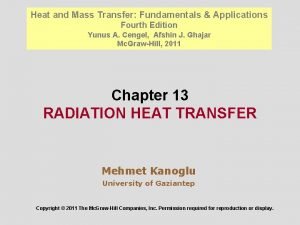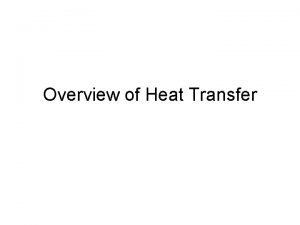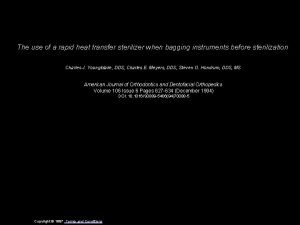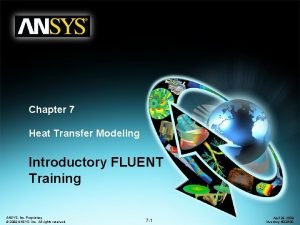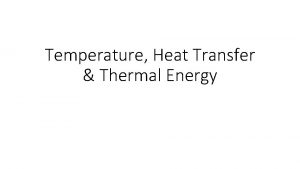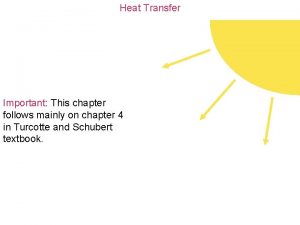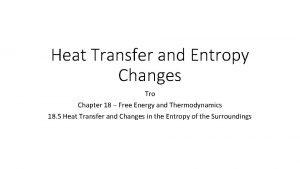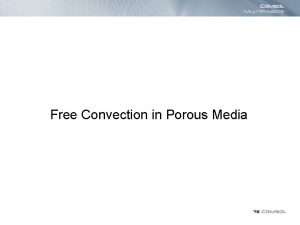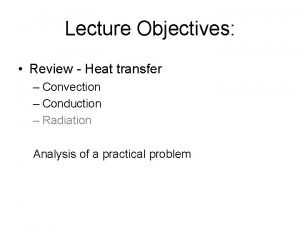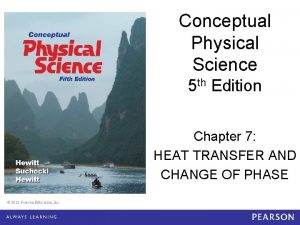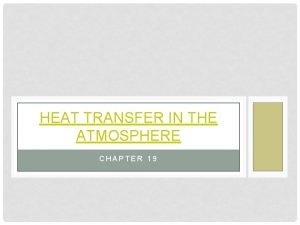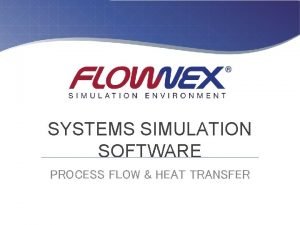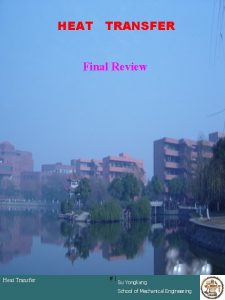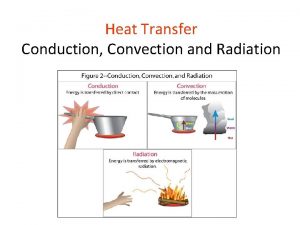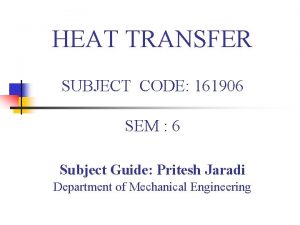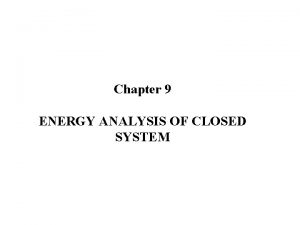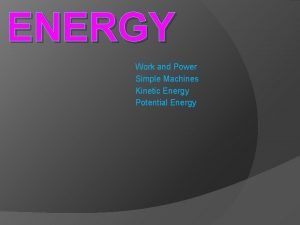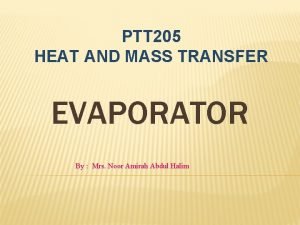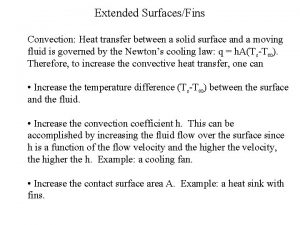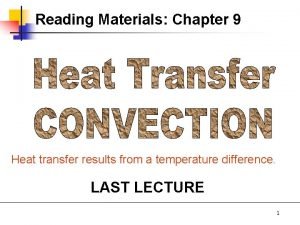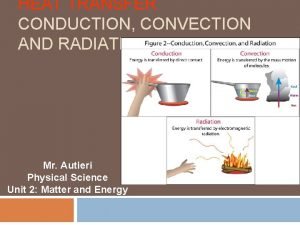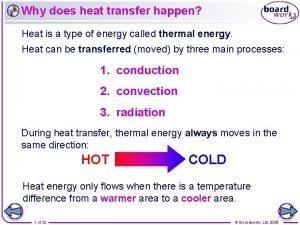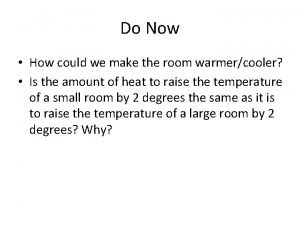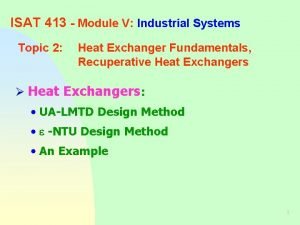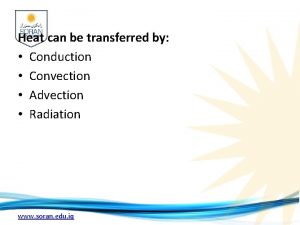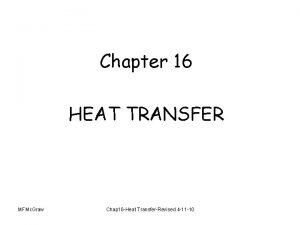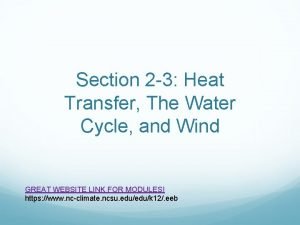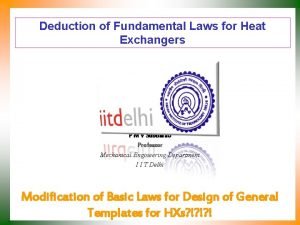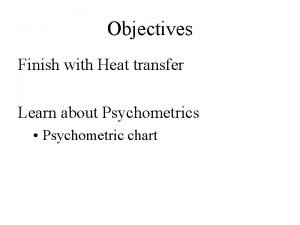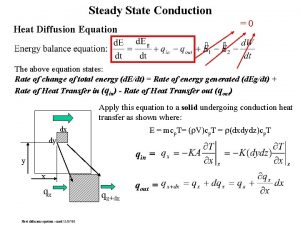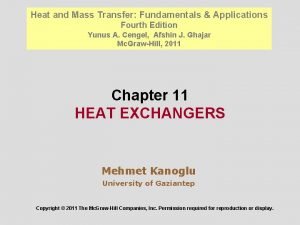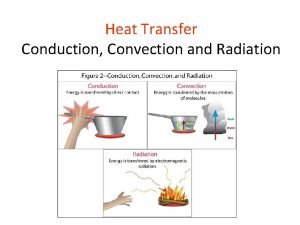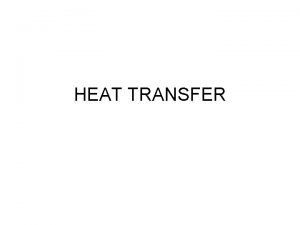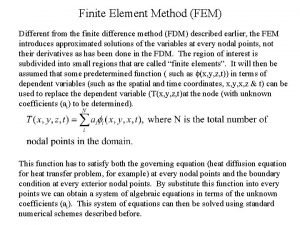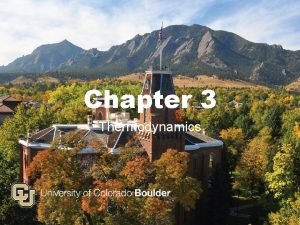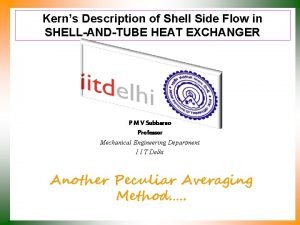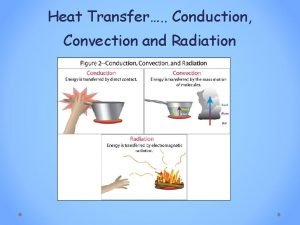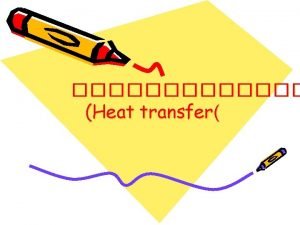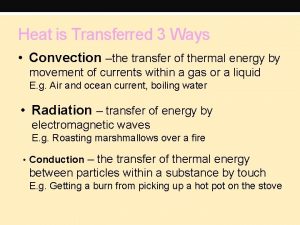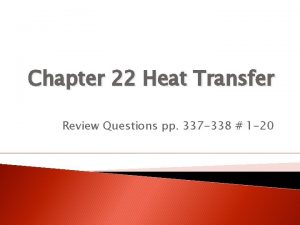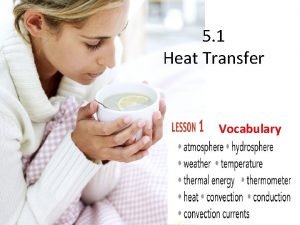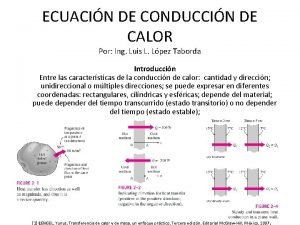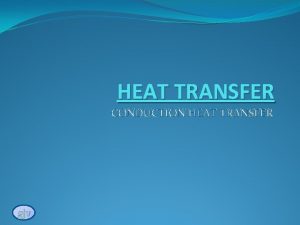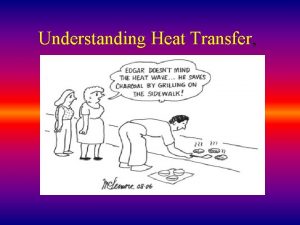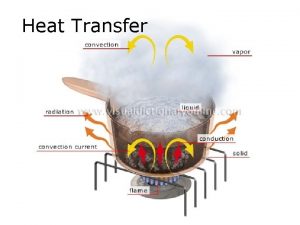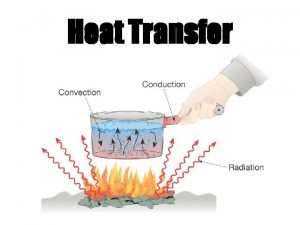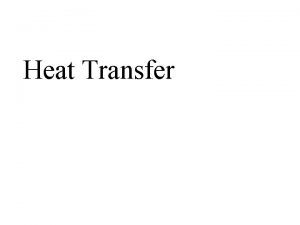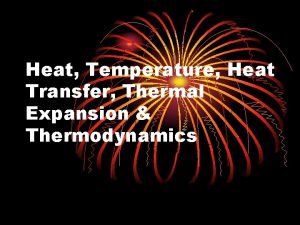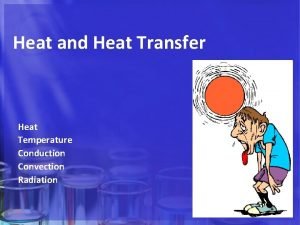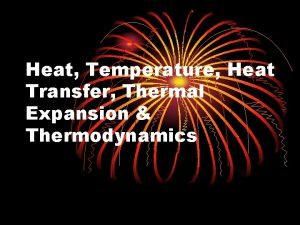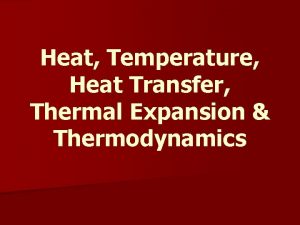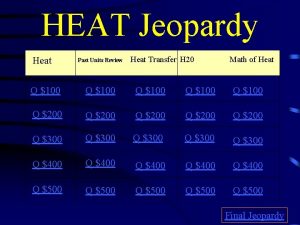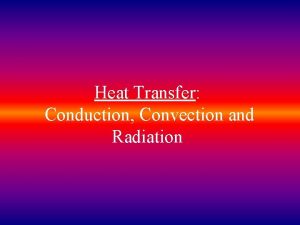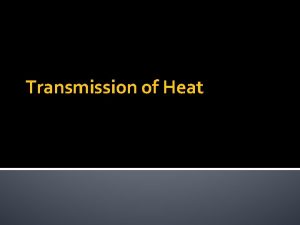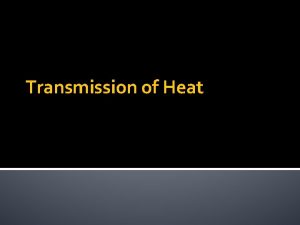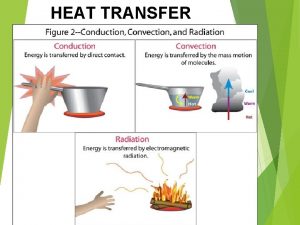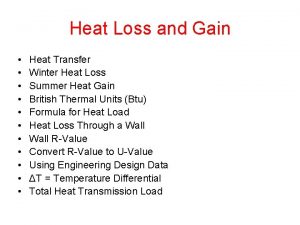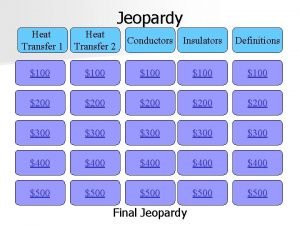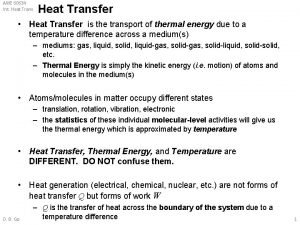FUNDAMENTAL OF HEAT TRANSFER Fundamentals of Heat Transfer















































- Slides: 47

FUNDAMENTAL OF HEAT TRANSFER

Fundamentals of Heat Transfer Heat flows from a hot or warm medium to a cold medium in three ways : 1 2 3 Conduction Convection Radiation Heat transfer through solid or fluid materials Heat transfer involves the physical movement of air Heat transfer from warm surface to cooler surface through air or vacuum Conduction Convection Sunlight Radiation

Radiant Heat Transfer

Radiation Radiant Heat / energy from sun light (IR - heat rays) Strike other object surface absorbed, temp. Energy strike a object surface, absorbed, temp. Radiation between surface

What is a Radiant Barrier?

What is a Radiant Barrier? Definition …. p A radiant barrier consists of a layer of metallic foil, with low emittance, that significantly reduces the transfer of heat energy radiated from “hotter” surfaces to “colder” surfaces (e. g. , the deck of an attic to the attic floor). p Among the benefits of installing radiant barriers are energy savings, $ savings, and comfort.

What is a Radiant Barrier? How they work … Radiant barriers reduce radiated heat transfer rate by the combination of the low emittance/ high reflectance properties of the foil.

What is a Radiant Barrier? Benefits … “Preventing the sun's radiation from entering through the roof can make a significant contribution to comfort and reduction in cooling bills/needs. ” From: Sustainable Building Sourcebook, Chapter: Energy

Industrial Laminates Products “The Ultimate Choice For Insulation”

Difference feature of Radiant barrier & Reflective insulation SIRIM Certified to MS ISO 9001: 2000 Registration no. AR 0385 RIMM SIRIM “The Ultimate Choice For Insulation”

Types of 1 Woven Foil 2 Paper Foil 3 Bubble Foil 4 Foam Foil 5 Veno Foils

Types of 1 Woven Foils

Advantage a) b) c) d) Excellence tear resistant Light weight and high strength Good vapor barrier No wire netting require for installation Disadvantage a) Uneven surface b) Higher shrinkage

Types of 1 Foils Woven Foil Single Sided Non Fire Retardant Alum Double Sided Alum / MPET Alum / Alum Single Sided Fire Retardant Alum Double Sided Alum / MPET Alum / Alum

Types of 2 Paper Foils

Advantage a) Good surface appearance b) No shrinkage c) Lower cost Disadvantage a) b) c) d) Easy to tear Low strength Need wire netting to support Moisture sensitive

Types of 2 Foils Paper Foil Single Sided Non Fire Retardant MPET Double Sided MPET / MPET Fire Retardant Double Sided Alum / MPET Alum / Alum

Types of 3 Bubble Foils

Advantage a) b) c) d) e) Good surface appearance Better R-value Better sound barrier No wire netting require Good vapor barrier Disadvantage a) b) c) d) Easy to tear Lower strength Higher cost Bulky

Types of 3 Foils Bubble Foil Single Sided Non Fire Retardant Alum Double Sided Alum / MPET Alum / Alum Fire Retardant Double Sided Alum / MPET Alum / Alum

Types of 4 Foam Foils

Advantage a) b) c) d) e) Good surface appearance Better R-value Better sound barrier No wire netting require Good vapor barrier Disadvantage a) Higher cost b) Bulky

Types of 4 Foils Foam Foil XFR 302 A-5 Alum/Alum Fire Retardant XFR 302 A-10 Alum/Alum

Types of 5 Foils Veno Foil Single Sided Non Fire Retardant Alum / PET Double Sided Alum / MPET Single Sided Fire Retardant Alum / PET Double Sided Alum / MPET

Introducing … New Innovation of Radiant Barrier

Leno Fabric - Interlocking of yarns - Open weav system - Reduce material usage - High tear resistant - excellence appearance Woven Fabric - Non-interlocking yarns - Close weav system - More material usage - High tear resistant - Uneven surface

Comparison On R-Value For Mass Insulation vs Reflective Insulation Materials (ASTM C 518) 1. 20 1. 02 1. 00 R VALUE 0. 80 0. 60 0. 40 0. 23 0. 20 0. 12 0. 00 0. 15 0. 12 TYPES OF INSULATION Rockwool (60 kg/m 3) Foam Foil (10 mm) Foam Foil (5 mm) Bubble Foil (ø 30 mm) Bubble Foil (ø 10 mm)

Comparison On R-Value For Mass Insulation vs Reflective Insulation Material with 50 mm Air Gap Top & Bottom (ASTM C 518) 3. 00 2. 47 2. 50 2. 33 2. 29 2. 17 R VALUE 2. 00 1. 50 1. 02 1. 00 0. 50 0. 00 TYPES OF INSULATION Rockwool (60 kg/m 3) Foam Foil (10 mm) Foam Foil (5 mm) Bubble Foil (ø 30 mm) Bubble Foil (ø 10 mm) Woven Foil (140μ)

MS 2095: 2014 Radiant Barrier and Reflective Insulation Building Materials Specification

FOURTH SCHEDULE Standards for Certification of Construction Material

Installation method SIRIM Certified to MS ISO 9001: 2000 Registration no. AR 0385 RIMM SIRIM “The Ultimate Choice For Insulation”

Important guideline To ensure reflective insulation system work, the following installation guideline are important: a) The low emissivity surface(high reflective surface) face the air gap. b) Ensure no roof leaking, aluminium will oxidize. c) 3 -6 inch overlapping at the edge. d) Avoid installation during raining day.

SINGLE METAL ROOF SYSTEM (radiant barrier + Mass Insulation + wire netting) 2 1 3 1 Metal roof 2 Screw 4 5 6 7 3 Insulation felt 4 Mass insulation 5 Reflective foil 6 Wire netting 7 C-Purlin

SINGLE METAL ROOF SYSTEM (radiant barrier + Mass Insulation) 2 1 3 4 6 5 1 Metal roof 2 Screw 3 Insulation felt 4 Mass insulation 5 Reflective foil 6 C-Purlin

DOUBLE METAL ROOF SYSTEM (radiant barrier + Mass Insulation) 2 1 3 4 6 1 Metal roof 2 Screw 3 Insulation felt 5 7 4 Mass insulation 5 Reflective foil 6 C-Purlin 7 Metal roof

SINGLE METAL ROOF SYSTEM (reflective insulation- foam/bubble foil) 2 1 3 4 5 1 Metal roof 2 Screw 3 Insulation felt 4 Reflective insulation 5 C-Purlin

DOUBLE METAL ROOF SYSTEM (reflective insulation- foam/bubble foil) 2 1 3 5 4 6 1 Metal roof 2 Screw 3 Insulation felt 4 Reflective insulation 5 C-Purlin 6 Metal roof

SINGLE METAL ROOF SYSTEM (reflective insulation- foam/bubble foil) 2 3 1 4 5 6 7 1 Metal roof 2 Screw 3 Insulation felt 4 Z- spacer 5 Screw 6 Reflective insulation 7 C-Purlin

DOUBLE METAL ROOF SYSTEM (reflective insulation- foam/bubble foil) 2 3 1 4 5 1 Metal roof 2 Screw 6 7 3 Insulation felt 4 Z- spacer 8 5 Screw 6 Reflective insulation 7 C-Purlin 8 Metal roof

RESIDENTIAL PITCH ROOF - OPEN ROOF SYSTEM (radiant barrier/reflective insulation)

DOUBLE METAL CLADDING 6 1 External metal cladding 2 Screw 3 Mass insulation 4 C channel metal purlin 5 Reflective foil 5 3 1 2 4 7 6 Airspace 7 Internal metal cladding

SINGLE METAL CLADDING 1 External metal cladding 2 Screw 3 Mass insulation 4 C channel metal purlin 5 Reflective foil 5 3 1 2 4

CONCRETE WALL 1 Concrete slab 2 Mass insulation 5 2 3 1 4 3 6 Reflective foil 4 Wooden purlin 5 Airspace 6 10 mm plasterboard

EXTERNAL FIBER BOARD WALL SYSTEM 1 Fiber board 5 2 Mass insulation 2 3 1 4 6 3 Reflective foil 4 Wooden purlin 5 6 Airspace 10 mm plasterboard

BRICK WALL SYSTEM 1 Brick wall 5 2 Mass insulation 2 3 1 4 6 3 Reflective foil 4 Wooden purlin 6 5 Airspace 10 mm plasterboard

End Of Presentation

Questions & Answers Session Quality Assurance
 Heat transfer
Heat transfer Fundamentals of heat and mass transfer 4th edition
Fundamentals of heat and mass transfer 4th edition Fundamental of heat and mass transfer
Fundamental of heat and mass transfer Disturbance that transfers energy
Disturbance that transfers energy The overall heat transfer coefficient
The overall heat transfer coefficient Heat transfer in bioprocess
Heat transfer in bioprocess Rapid heat transfer
Rapid heat transfer Conjugate heat transfer ansys
Conjugate heat transfer ansys Example of heat energy
Example of heat energy Heat transfer
Heat transfer Q system = -q surroundings
Q system = -q surroundings Free and porous media flow comsol
Free and porous media flow comsol Radiation flux equation
Radiation flux equation Chapter 7 heat transfer and change of phase
Chapter 7 heat transfer and change of phase Heat transfer on earth
Heat transfer on earth Heat transfer simulation software
Heat transfer simulation software Heat transfer final exam
Heat transfer final exam Radiation examples
Radiation examples Heat transfer subject code
Heat transfer subject code Heat transfer in polytropic process
Heat transfer in polytropic process A crane uses an average force of 5200 n
A crane uses an average force of 5200 n Open kettle or pan evaporator
Open kettle or pan evaporator Advection vs convection
Advection vs convection Convection heat transfer
Convection heat transfer Heat transfer examples
Heat transfer examples Heat transfer of metals
Heat transfer of metals Following charting convection used in work study
Following charting convection used in work study Ntu heat transfer
Ntu heat transfer Advection heat transfer
Advection heat transfer Boiling curve in heat transfer
Boiling curve in heat transfer Heat transfer cylinder
Heat transfer cylinder Condensation process example
Condensation process example The law of heat exchange
The law of heat exchange Radiation heat transfer coefficient
Radiation heat transfer coefficient Convection definition
Convection definition Diffusion equation
Diffusion equation The overall heat transfer coefficient
The overall heat transfer coefficient Radiation heat transfer examples
Radiation heat transfer examples How does heat move
How does heat move Governing equation heat transfer
Governing equation heat transfer Advection heat transfer
Advection heat transfer Tube layout angle
Tube layout angle Methods of heat transfer
Methods of heat transfer Triple pipe heat exchanger
Triple pipe heat exchanger Conduction in water
Conduction in water How does archimedes principle relate to convection
How does archimedes principle relate to convection Heat transfer vocabulary
Heat transfer vocabulary Generación del calor
Generación del calor
